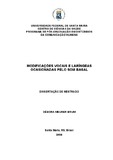| dc.creator | Brum, Débora Meurer | |
| dc.date.accessioned | 2007-02-08 | |
| dc.date.available | 2007-02-08 | |
| dc.date.issued | 2006-08-21 | |
| dc.identifier.citation | BRUM, Débora Meurer. Vocal and laringeal changes caused by vocal fry. 2006. 82 f. Dissertação (Mestrado em Fonoaudiologia) - Universidade Federal de Santa Maria, Santa Maria, 2006. | por |
| dc.identifier.uri | http://repositorio.ufsm.br/handle/1/6510 | |
| dc.description.abstract | The present study aimed at examining both vocal and laryngeal changes caused by the vocal fry in five female subjects without vocal complaints, signs nor symptoms, with no report of previous voice therapy, and free of inflammatory or allergic processes at the moment of assessment. Initially, a digital recording of sustained emission of /a/ vowel and a recording of a videostroboscopic examination of larynx were performed. Soon after this procedure, the subjects did the vocal fry, in three series of 15 repetitions, with a 30-second interval of passive rest between the series, when the subjects should remain in absolute silence. Immediately after that, both the laryngeal examination and the recording of the vocal emission with the same phonatory task were carried out again. Both laryngeal and vocal data found prior to and after the technique were submitted to acoustic, perceptive-auditive, and videostroboscopic analyses. The perceptive-auditive analysis as well as the videostroboscopic one were performed by six judges (three speech and language pathologists especialized in voice, and three otorhinolaryngologist, respectively). The
acoustic analysis was generated by the Multi Speech program of Kay Elemetrics. The analysis of results showed the following effects of the vocal fry: improved vibration of the mucosa of the vocal folds, particularly as to width and symmetry of vibration; improved or sustained voice type and pitch; improved or sustained parameters related to jitter and shimmer as well as the index that suggests glottic noise, suggesting decreased noise; improved index of mild phonation, suggesting greater balance of the degree of coaptation strength and completion of vocal folds closure; sustained or worsened vocal quality and resonance focus, with laryngopharyngeal prevalence; decreased fundamental frequency; and increased frequency variation and width, suggesting phonatory unstableness. Thus, in this study, it was concluded that the vocal fry had a positive effect on the vibration of the mucosa of the vocal folds andon the voice noise as well, and a negative effect on the voice resonance and stability. | eng |
| dc.format | application/pdf | por |
| dc.language | por | por |
| dc.publisher | Universidade Federal de Santa Maria | por |
| dc.rights | Acesso Aberto | por |
| dc.subject | Fonoaudiologia | por |
| dc.subject | Voz | por |
| dc.subject | Som basal | por |
| dc.subject | Técnica vocal | por |
| dc.subject | Reabilitação vocal | por |
| dc.subject | Speech and language pathology | eng |
| dc.subject | Voice | eng |
| dc.subject | Vocal fry | eng |
| dc.subject | Vocal technique | eng |
| dc.subject | Voice rehabilitation | eng |
| dc.title | Modificações vocais e laríngeas ocasionadas pelo som basal | por |
| dc.title.alternative | Vocal and laringeal changes caused by vocal fry | eng |
| dc.type | Dissertação | por |
| dc.description.resumo | O presente estudo teve como objetivo verificar as mudanças vocais e laríngeas ocasionadas pelo som basal em cinco indivíduos adultos do sexo feminino sem queixas, sinais e sintomas vocais e laríngeos, sem relato de terapia vocal anterior e livres de quadro inflamatório ou alérgico no momento da avaliação. Inicialmente, realizou-se gravação digital da emissão sustentada da vogal /a/ e gravação do
exame videolaringoestroboscópico da laringe. Imediatamente após, os sujeitos realizaram a técnica do som basal durante três séries de 15 repetições. Em seguida, realizaram-se novamente o exame laríngeo e a gravação da emissão vocal com a mesma tarefa fonatória. Os dados laríngeos e vocais pré e pós-realização da técnica foram submetidos às análises acústica, perceptivo-auditiva e videolaringoestroboscópica, sendo as duas últimas realizadas por seis juízes (três
fonoaudiólogas especialistas em voz e três otorrinolaringologistas, respectivamente). A análise acústica foi gerada pelo programa Multi Speech, da Kay Elemetrics. A
análise dos resultados evidenciou que o som basal propiciou: melhora da vibração da mucosa das pregas vocais, mais especificamente quanto à amplitude e simetria de vibração; melhora ou manutenção do tipo de voz e do pitch; melhora ou
manutenção dos parâmetros relacionados ao jitter e shimmer (PPQ e APQ) e do índice que sugere ruído glótico (NHR), sugerindo diminuição do ruído; melhora do índice de fonação suave (SPI), sugerindo maior equilíbrio do grau de força de
coaptação e da completude de fechamento das pregas vocais; manutenção ou piora da qualidade vocal e do foco ressonantal, com predomínio laringofaríngeo;diminuição da freqüência fundamental; e aumento da variação da freqüência (vf0) e amplitude (vAm), sugerindo instabilidade fonatória. Dessa forma, concluiu-se que, neste estudo, o som basal promoveu um efeito positivo sobre a vibração da mucosa
das pregas vocais e sobre o ruído na voz, e um efeito negativo sobre a ressonância e a estabilidade da voz. | por |
| dc.contributor.advisor1 | Cielo, Carla Aparecida | |
| dc.contributor.advisor1Lattes | http://lattes.cnpq.br/8424979142095675 | por |
| dc.contributor.referee1 | Keske-Soares, Marcia | |
| dc.contributor.referee1Lattes | http://lattes.cnpq.br/2993790524055307 | por |
| dc.creator.Lattes | http://lattes.cnpq.br/3575555967532649 | por |
| dc.publisher.country | BR | por |
| dc.publisher.department | Fonoaudiologia | por |
| dc.publisher.initials | UFSM | por |
| dc.publisher.program | Programa de Pós-Graduação em Distúrbios da Comunicação Humana | por |
| dc.subject.cnpq | CNPQ::CIENCIAS DA SAUDE::FONOAUDIOLOGIA | por |


